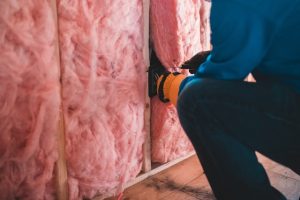Container homes are the 21st century’s new craze. They are affordable, stylish, and eco-friendly. However, the most important aspect of a container home is the insulation. Without proper insulation, the heat and cold will seep in, making the container home uncomfortable during the summer and winter months.
The right materials are essential for efficient insulation of a container home. As a matter of fact, 90% of the success of your container home depends on the insulation materials you choose. That’s why you need to Baubedarf Produkte kaufen which provide the right insulation.
Proper insulation can’t be compromised if you want to keep your home cool even in the scorching summer and warm in the freezing winter. So, let’s get started and look at the best materials for efficient insulation that every container home must have.
Spray Foam Insulation
 When it comes to insulating your container home, spray foam insulation is a game-changer. This versatile material expands upon application, filling every nook and cranny to make a seamless barrier against heat transfer. Its high R-value ensures maximum thermal efficiency, keeping your home comfortable year-round. The best thing about it is its ability to resist moisture infiltration. As it creates an airtight seal, you can rest assured your home will be away from mold and mildew growth while maintaining indoor air quality.
When it comes to insulating your container home, spray foam insulation is a game-changer. This versatile material expands upon application, filling every nook and cranny to make a seamless barrier against heat transfer. Its high R-value ensures maximum thermal efficiency, keeping your home comfortable year-round. The best thing about it is its ability to resist moisture infiltration. As it creates an airtight seal, you can rest assured your home will be away from mold and mildew growth while maintaining indoor air quality.
Fiberglass Batts or Rolls
These insulation materials are made of tiny glass fibers and come in pre-cut sheets (batts) or long blankets (rolls). They are easy to install, making them a convenient option for DIY projects. Fiberglass insulation is known for its thermal resistance properties, helping keep your home warm in the winter and cool in the summer. It also provides excellent soundproofing qualities, creating a quiet and comfortable living space inside your container home.
Rigid Foam Insulation: Extruded Polystyrene (XPS)
Another insulation material worth mentioning is the extruded polystyrene (XPS). This type of insulation offers excellent thermal resistance, helping to keep the interior temperature stable regardless of external conditions. XPS is known for its durability and moisture resistance, making it ideal for use in shipping container structures. One key advantage of XPS insulation is its high compressive strength, which helps maintain structural integrity over time. Additionally, XPS does not absorb water or support mold growth, ensuring a healthy indoor environment. Its lightweight nature makes installation easy and efficient compared to other types of insulation materials.
Reflective Foil Insulation
 Though it might not be as popular as the other, reflective foil insulation is still a great option for insulating container homes. It consists of layers of aluminum foil, backed with other materials like polyethylene bubbles or foam. The shiny surface reflects heat away, helping to keep the interior cool in hot climates and warm in colder temperatures. Due to its lightweight nature, it doesn’t add extra weight to the structure of the container home.
Though it might not be as popular as the other, reflective foil insulation is still a great option for insulating container homes. It consists of layers of aluminum foil, backed with other materials like polyethylene bubbles or foam. The shiny surface reflects heat away, helping to keep the interior cool in hot climates and warm in colder temperatures. Due to its lightweight nature, it doesn’t add extra weight to the structure of the container home.
In addition to its insulating properties, reflective foil insulation also works as a vapor barrier, preventing moisture buildup within the walls. When it comes to building a container home, choosing the right insulation materials is crucial for energy efficiency and comfort. With the right combination of building supplies and insulation materials in place, you can transform your container space into a cozy retreat that stands the test of time.

